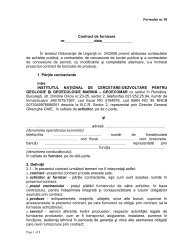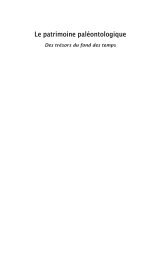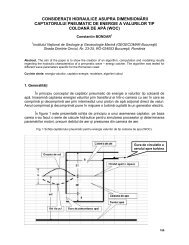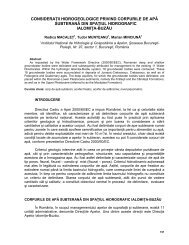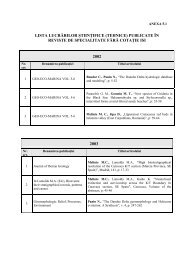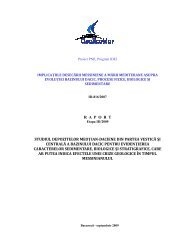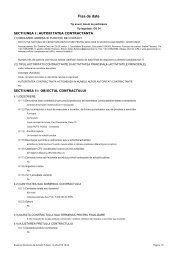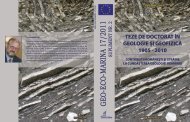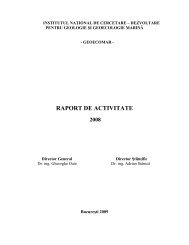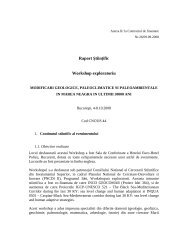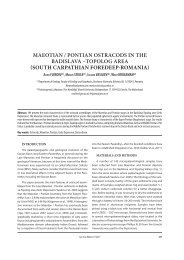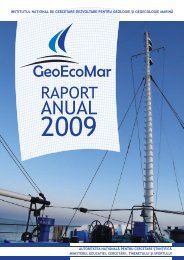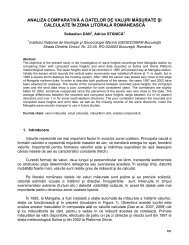THE PALAEOZOIC BRACHIOPODS OF ROMANIA - GeoEcoMar
THE PALAEOZOIC BRACHIOPODS OF ROMANIA - GeoEcoMar
THE PALAEOZOIC BRACHIOPODS OF ROMANIA - GeoEcoMar
You also want an ePaper? Increase the reach of your titles
YUMPU automatically turns print PDFs into web optimized ePapers that Google loves.
Magdalena lordan - The Palaeozoic brachiopods of Romania<br />
(lordan 1984, 1985; lordan ef a/., 1985; lordan, Spasov, podolica Kozl., Schellwienella umbraculum (Schl.),<br />
1989). In both boreholes the faunal assemblages are of Pletorhyncha cf. speclosa (Hall), Chonetes<br />
neritic and litoral type, sometimes with characters<br />
suggesting shallow water carbonate environment.<br />
(Plebejochonetes) unkelensis Dahm., Eodevonaria<br />
arcuata (Hall), Fimbispirifer daleidensis (Stein.),<br />
Wenlockian brachiopods /sorthrs a'f'f. clivosa Walm., Costi s p i rife r arerosus (Con rd. )., N aj a d o s p i iter n aj ad u m<br />
Morinorhynchus cf . orbignyi (Dav.), Lissostrophia (L.) cf . (Barr.), /sorfhis sp., Sfrophodonta sp., Chonefes sp.,<br />
cooperi Ams., Mesopholidostrophia sp. (Plate ll), Megantheis sp., Camarotoechia sp., Delthyis sp.,<br />
together with long range (Llandoverian-Ludlovian) Uncinulusp. (Plate ll).<br />
Leptaena rhomboidalis (Wahl.) and Atrypa aff . reticularis<br />
The gritty Eifelian is characterized by abundance of<br />
Linn. and with Wenlockian palynomorphs are identified<br />
in the green siltstones of the Girla Mare borehole<br />
(lordan, 1992, 1999). The Ludlovian brachiopods<br />
Fardenia cf . wieniukovi (Kozl.), Howellella cf . bragensis<br />
(Wenj.) and Sfrophodonta sp. were identified in the<br />
Oprisor borehole.<br />
Devonian<br />
In the Romanian part of the Moesian Platform, all the<br />
Devonian stages of the Renish-Ardenne type were<br />
identified. We try to correlate these with the international<br />
standards.<br />
The Lochkovian (Gedinnian), attested in the Oprisor<br />
borehole by the lcriodus woschmidti conodont zone,<br />
contains brachiopod fragments of Strophomenids as<br />
well as Spiriferids, crinoids, corals and orthoceratids.<br />
The Praguian (Siegenian), attested by the<br />
tentacufites zones Nowakia (Turkestanella) acuaria and<br />
Tentaculites straeleni also contains brachiopods,<br />
bivalves, crinoids, corals, gastropods. The following<br />
brachiopods were identified in the Oprisor and Mangalia<br />
boreholes (lordan, 1981, 1985, 1988, '1992b, 1999c):<br />
Orbiculoidea sp , lridistrophia euzona (Fuchs) Chonetes<br />
amaliana de Kon., Delthyris dumontianus (de Kon.), D.<br />
infans Dahmer, Stropheodonta sp., Mutationella<br />
podolica Kozl., Trigonorhynchia daleidensis (Roem.),<br />
Vandercammenina trigeri (Vern.) (Plate ll). Although<br />
diversified, they are on the second place following the<br />
tentaculites, are numerically equal with bivalves and are<br />
more numerous than gastropods, crinoids and corals.<br />
The Zlichovian (Lower Emsian), attested by the<br />
trilobites zones Pseudocryphaeus prostellans, Pilletina<br />
a si at i c a and D i p I e u ra fo rn ix (Mangdia, Calarasi) ( lordan,<br />
1967, 1981, 1985) contains predominantly trilobites and<br />
bivalves and subordinately brachiopods, gastropods,<br />
orthoceratids, corals, crinoids, bryozoans. The following<br />
brachiopods were identified (Raileanu et al., 1966;<br />
fordan, 1981, 1985,'1988): Dignomia hunsruckiana<br />
Fuchs, Levenea cf . subcarinala (Hall), Mutationella<br />
psilophytal plants, placodermi and ostracodermi fishes<br />
and subordinately by brachiopods, tentaculitids,<br />
crinoids, bivalves, gastropods, corals. The following<br />
brachiopods were recorded: Lingulla aff. nuda Hall,<br />
Lingulipora sp., Rhipidomella penelope (Hall),<br />
Leptostrophia rotunda Bubl., Matuitoechia marki Havl.<br />
(Calarasi borehole), Fimbrispirifer sp., /sorfhis sp.,<br />
The Pridolian brachiopods of the tenuis and dayiana<br />
zones are Mesodouvillina subinterstrialis Kozl., Uncinulus sp,, Pholidostrophia sp. (Mangalia borehole),<br />
Eospiifer cf. schmidti Lindstr., Leptostrophia sp., Mediospirifer aff. audacula (Conr.) (Smirna borehole)<br />
Spondilostrophia sp., Shaleia sp., Strophochonefesp. (Plate ll). The presence of the Lingulids beside<br />
(Plate ll), were identified in both Girla Mare and Oprisor eurypterid arthropods, psilophytal plants and placodermi<br />
boreholes.<br />
fishes attest a littoral facies with alternating fresh and<br />
Several criteria enabled to correlate the Silurian sea water sedimentation (shallow shelf environment).<br />
shelly fauna facies of the Moesian and Moldavian<br />
Platforms: the presence of the "shelly fauna facies"<br />
without graptolites; a large number of common elements<br />
in the Chitinozoan assemblage (lasi and Batrinesti<br />
boreholes); the green colour of rocks, which in both<br />
regions is due to detrital chlorite (lordan ef a/., 1985).<br />
'1-he<br />
shelly fauna facies yielded a neritic shallow-water<br />
palaeontological assemblage which shows affinities with<br />
those in Avalonia, Bohemia, Podolia, and Baltic basins<br />
(lordan, 1992b, 1999c).<br />
nalivkini Havl.,<br />
'Spirifef<br />
laevicosta Valenc.,<br />
Schellwienella sp., Iridistrophla sp. (Plate ll).<br />
The Givetian marks the beginning of the carbonateevaporitic<br />
facies in the Moesian Platform. lt is attested<br />
by the following zones: Tentaculites conicus,<br />
Fimbrispirifer yenusfus and Mucrospiifer mucronatus<br />
(lordan 1988, 1999c). The brachiopod assemblage<br />
consists of the species Strophodonta (S.) demissa<br />
(Conr.), Devonochonetes scitulus (Hall), Atrypa<br />
reticularis kuzbasica Rzhon., Mucrospirifer mucronatus<br />
(Conr.), Fimbrispirifer yenuslus (Hall), Punctatrypa<br />
The Frasnian is attested by the zones Homoctenus<br />
krestovnikovi and Mucrospirifer bauchardi. The<br />
brachiopods associated with fragments of crinoids,<br />
gastropods, corals and tentaculites are the following;<br />
Chonetes rowei Cl. et Sw., Athyris aff . vittata Hall., A.<br />
aff. nuculoidea Coop., Mucrospirifer bouchardi (Murch.),<br />
Spinocyrtia martianoffi (Stuck.), Mediospiifer audacula<br />
(Conr.)(Plate ll)(lordan 1981 , 1988, 1999c).<br />
The Famennian is attested by the brachiopods and<br />
conodont zones Cyrtospiifer archiaci and Palmatolepis<br />
crepida. Only the brownish-light grey limestones of the<br />
Viroaga borehole yielded a faunal assemblage<br />
consisting of brachiopods, gastropods, crinoids,<br />
conodonts, forams (moravaminids), holothurian sclerites<br />
and ophiuroids (lordan el al., 1987a; lordan 1985, 1988,<br />
1992b, 1999c). The brachiopod assemblage is<br />
dominated by Spiriferids, whereas Chonetids,<br />
Productids and Rhynchonelids are subordinate. The<br />
following brachiopods were identified: Cyrtospirifer<br />
archiaci (Murch.), C. cf . tchernychevi sibirica lvania, C.<br />
spp., Athyris sp., Productel/a sp., Megachonetes sp.,<br />
Camarotoechr'a sp. (Plate ll),<br />
Carboniferous<br />
All the stages of the Carboniferous system have<br />
been attested on the base of zones and age indicator<br />
fossils like gastropods, orthoceratids, fenestelides,<br />
corals, crinoids, plant debris, fish scales (lordan ef a/.,<br />
1987b; lordan 1985, 1992a, 1999a,c).<br />
The Visean is attested by the conodont zone<br />
Ligonodina fragilis and the brachiopods Schizophoria<br />
resupinata gigantea Dem., Gigantoproductus giganteus<br />
GEO-ECO-MARINA,4/1999<br />
t40<br />
National lnstitute of Marine Geology and Geo-ecology of Romania<br />
Proc. Intern. Workshop on "Modern and Ancient Sedimentary Environments and Processes" Moeciu, Romania, Oct. B -15, 1998



